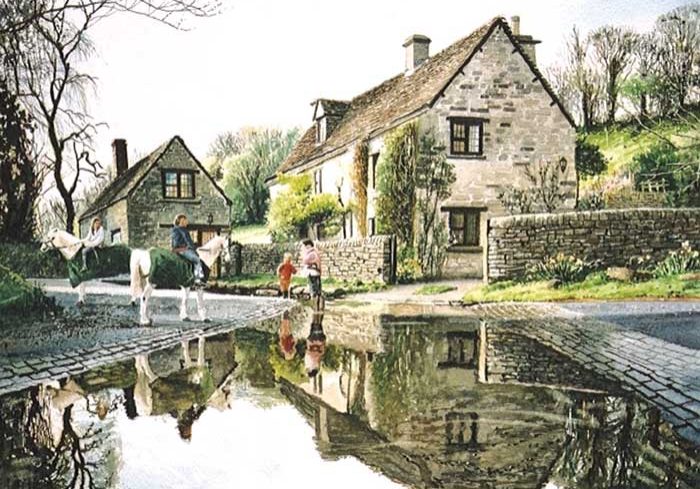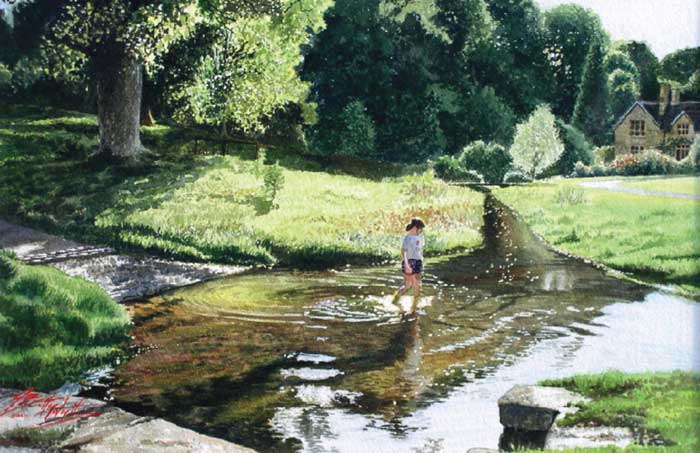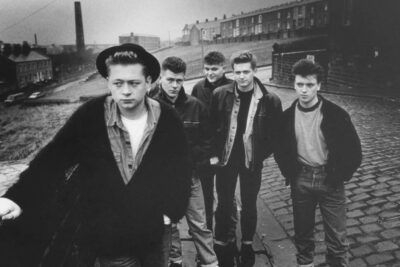
How to Paint Water by Geoff Butterworth
by Geoff Butterworth
People often ask me: “How do you paint water?” and it is not easy to answer. However I usually say that it is no different from painting a wall and they go away thinking: “Is that true…?”
I could leave it at that and sign off but we had better elaborate a bit and explain what I really mean.
We are talking about reflection, ambient light, and shades and tones; now that sounds a bit better, like I know what I am on about.
You could say that you paint a view, then turn your picture round and paint the view again and throw a duck into the mix. That might work but not all reflections are a mirror image. We get complex things like ripples or waves, stones and waterfalls, all thrown in to make the job a lot harder, or even more interesting.
Simply using watercolour does not mean we can throw a cup full of water on our paper and wait for the results. Sometimes, though, we do work on wet paper. Let me show you and explain…

The Ford at Lower Slaughter
The Cotswold picture is a study of the Ford at Lower Slaughter and shows off a water scene to great effect. With the use of masking fluid for the bright dots, ripples and sparkles, the first thing to paint is the ground. This is the riverbed which is painted with blurred details by working on slightly wet paper. I am carefully checking the view so that the colours are correct and the blurs from brown to light green work. The sky reflection was painted in when the background is dry. This is a tough painting to pull off but it shows water to good effect.
The masking fluid is removed when everything is dry and it picks out all the sparkly details and ripple lines around the paddling girl. The reflection of the girl can be painted in two ways, by painting it when you are working on the background with slightly wet paper or, later, by washing out the brown with clean water and a soft brush. This technique is called burning out and does work reasonably well and allows you to clean off some of the dark colour and get back to adding a lighter colour. You need to test the paper before you commit yourself to this, though, because some papers absorb more than others and removing is not as successful. The girl was painted last, but remember that with watercolour you cannot paint light onto dark so that is why the figure has to be left to the end.

Wildlife is always bobbing about on water so it is good to let these two geese swim into our piece.
The water is all the colours of the sky. The background and the two geese are painted in the same way but here it was drawn more accurately and painted with a flat brush instead of a round one. This creates the linear flow of the water better and with our masking fluid again, the small details are left until the end. This painting was done back in the mid eighties and proves that I am not really a wildlife artist, but I have a go now and then.
I am always saying that if you want light you have to have dark. The more darkness you put into a painting the more the light will shine out. This is certainly proved by the next watercolour painting. The subject was carefully chosen. Viewed from a dark shade towards the sunlight, this is the stream at Delph in the Saddleworth area near Oldham. The late afternoon sun dances on the water and the dark shadows create vivid contrasts throughout the painting. The figure was added into the scene to give a focal point to start your eye wandering round the image.

The Stream at Delph, near Oldham
The sea harbour at Scarborough was a great subject with the evening sun burning bright on the water. The light picks out all the details of the wharf and the distant buildings are almost fading into grey. The sea is sparkling and tiny waves are topped with shining light. This is realism and I love the effect that it gives. I deliberately chose this style, back in the days when I could not paint for toffee. I wanted a painting to take me back to a scene completely, with no lines and not weak colour. I went through dozens of paintings before I could pull it off and eventually arrived at my style which is not photorealism but true to life.

The Harbour at Scarborough
If we want a scene that is nearly a perfect double image then here we are, at another ford back in the Cotswolds. Duntisbourne Rouse, how’s that for a name?
This gorgeous village is quite out of the way but worth a look. It was a very still, early spring day and the two ponies came down for a drink so out came the camera and I fired of a few shots.
There is hardly any movement in the water so our mirror image is almost perfect. In a way it is more work to capture a still scene than a moving one as you are painting the view twice but in an opposite reflection. The colours change, turning a bit darker, and the slight movement of the water distorts the lines ever so slightly so we know that the water is there without need for sparkles and such. To be honest I would prefer sparkle and movement but short of hurling a brick into the ford I left things as they were. A perfect English Watercolour.

Duntisbourne Rouse, Cotswolds
Just room for one more and we are in Yorkshire at Kettlewell, right down in the water and balancing on a stone, probably.
Sometimes things go wrong and I end up in the water. This happened by the steep bank of a reservoir while I was leaning over the water with my camera, holding onto a branch. Two jets kindly blasted over at a ridiculously low altitude and I jumped and the branch snapped off.
I slowly stepped down the banking unable to stop until I was up to my chin. All sorts crawled out of my trousers on the soggy drive home. But back in Kettlewell all is fine, and dry.
This painting is a study of the river with a lot of colour and wetness (a technical term) not really but it does describe the effect.
Don’t ask me how I painted it. Sometimes I am so busy listening to music I am not aware of what is going on. If you want a painting lesson at my studio, find out how by viewing my website at geoffbutterworth.co.uk.

Kettlewell, North Yorkshire




